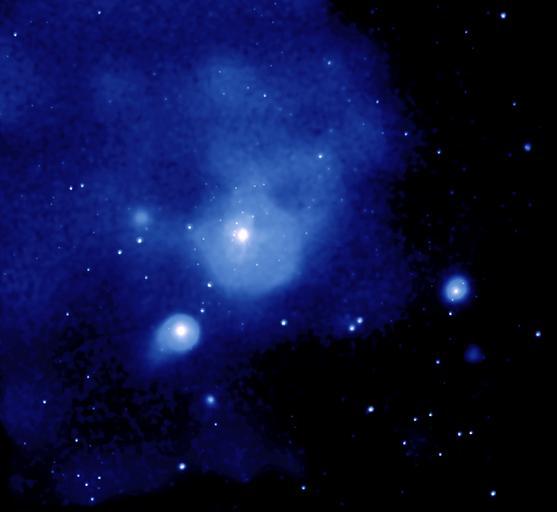MAKE A MEME
View Large Image

| View Original: | A_nearby_galaxy_cluster_about_65_million_light_years_from_Earth..jpg (2400x2205) | |||
| Download: | Original | Medium | Small | Thumb |
| Courtesy of: | www.flickr.com | More Like This | ||
| Keywords: smithsonian institution smithsonianinstitution fornax cluster fornaxcluster galaxy nasa chandra heavens stars light bright time and space timeandspace blue color photograph of space colorphotographofspace space satellite images satelliteimages night sky nightsky universe espacio sideral espaciosideral univers galaxies falling galaxiesfalling smithsonian astrophysical observatory smithsonianastrophysicalobservatory outdoor Description: Chandra's mosaic of images of the Fornax cluster reveals that the vast cloud of ten-million-degree Celsius gas in the core of the cluster has a swept-back cometary shape that extends for more than half a million light years. This geometry suggests that the hot gas cloud is moving through a larger, but less dense cloud of gas that creates an intergalactic headwind. The core motion, combined with optical observations of the motion of a group of galaxies falling toward the core, indicates that the cluster lies along a large, unseen, filamentary structure composed mostly of dark matter. Most galaxies, gas, and dark matter in the universe are thought to be concentrated in such filaments, and galaxy clusters are thought to form where the filaments intersect. Creator/Photographer: Chandra X-ray Observatory NASA's Chandra X-ray Observatory, which was launched and deployed by Space Shuttle Columbia on July 23, 1999, is the most sophisticated X-ray observatory built to date. The mirrors on Chandra are the largest, most precisely shaped and aligned, and smoothest mirrors ever constructed. Chandra is helping scientists better understand the hot, turbulent regions of space and answer fundamental questions about origin, evolution, and destiny of the Universe. The images Chandra makes are twenty-five times sharper than the best previous X-ray telescope. NASA's Marshall Space Flight Center in Huntsville, Ala., manages the Chandra program for NASA's Science Mission Directorate in Washington. The Smithsonian Astrophysical Observatory controls Chandra science and flight operations from the Chandra X-ray Center in Cambridge, Massachusetts. Medium: Chandra telescope x-ray Date: 2004 Persistent URL: chandra.harvard.edu/photo/2004/fornax/ Repository: Smithsonian Astrophysical Observatory Gift line: NASA/CXC/Columbia U./C.Scharf et Accession number: fornax_xray Description: Chandra's mosaic of images of the Fornax cluster reveals that the vast cloud of ten-million-degree Celsius gas in the core of the cluster has a swept-back cometary shape that extends for more than half a million light years. This geometry suggests that the hot gas cloud is moving through a larger, but less dense cloud of gas that creates an intergalactic headwind. The core motion, combined with optical observations of the motion of a group of galaxies falling toward the core, indicates that the cluster lies along a large, unseen, filamentary structure composed mostly of dark matter. Most galaxies, gas, and dark matter in the universe are thought to be concentrated in such filaments, and galaxy clusters are thought to form where the filaments intersect. Creator/Photographer: Chandra X-ray Observatory NASA's Chandra X-ray Observatory, which was launched and deployed by Space Shuttle Columbia on July 23, 1999, is the most sophisticated X-ray observatory built to date. The mirrors on Chandra are the largest, most precisely shaped and aligned, and smoothest mirrors ever constructed. Chandra is helping scientists better understand the hot, turbulent regions of space and answer fundamental questions about origin, evolution, and destiny of the Universe. The images Chandra makes are twenty-five times sharper than the best previous X-ray telescope. NASA's Marshall Space Flight Center in Huntsville, Ala., manages the Chandra program for NASA's Science Mission Directorate in Washington. The Smithsonian Astrophysical Observatory controls Chandra science and flight operations from the Chandra X-ray Center in Cambridge, Massachusetts. Medium: Chandra telescope x-ray Date: 2004 Persistent URL: chandra.harvard.edu/photo/2004/fornax/ Repository: Smithsonian Astrophysical Observatory Gift line: NASA/CXC/Columbia U./C.Scharf et Accession number: fornax_xray | ||||